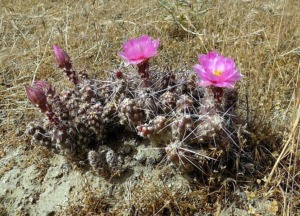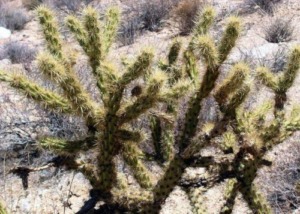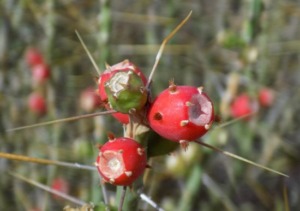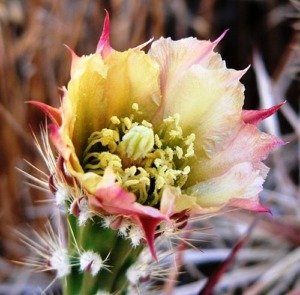Introduction
The first iteration of Cholla Web was built in 2006 as a part of Opuntiads of the USA, and it identified many cholla species of the United States. Scientific expertise, records recovery, and field studies, etc., allowed us to refine the site until it is what you see today.

Our scientists identify species in the field and, in addition to extensive field studies, we consulted herbarium specimens, scientific citations, and written descriptions. Perhaps most importantly, field botanists who work with chollas serve as editors. Additionally, we consulted with other scientists on an ad hoc basis. Herein, we provide evidence to support our conclusions in the form of descriptions, photo-reproductions of herbarium samples, published literature, and photographs of plants in the field.
A single citation was used to determine a taxon name. The precise citation chosen provides the earliest identifying name for the taxon as we treat it and a place for the reader to start if more taxonomic information is desired. Many (most?) Cylindropuntia species and Grusonia species were originally identified as Opuntia species. We cite these older descriptions because they are often the first appearance of a taxon in the literature.
What is a species?

Identification of cholla species requires a working sense of what a species is. We use the following two considerations as our guide to defining a species. Species are “clusters of monotypic or polytypic biological entities, identified using morphology or genetics, forming groups that have few or no intermediates with other groups when in contact.”
Secondly, we accept that species are “groups of organisms that inherit characteristics from each other, have a common gene pool, and are a reproductive community that forms a genetic unit.”
Details
To make decisions, we mostly consider phenotypic and gross morphological information such as spine colors, sizes, numbers, and arrangements; glochid arrangements, sizes, and colors; cladode shape, color, and overall morphology; areole details including distributions; fruit morphology, size, and color; general plant aspect, size, and shape; etc. Elevation and geographic location are considered. If observable, we also consider other types of data (e.g., presence/absence of hybrids) in making decisions about the limits of a taxon. Ploidies are determined by our editors or are reported in the literature.
Other data, such as physiology, internal anatomy, phenology, pollination ecology, ecosystem position, and proposed phylogenies; etc., are mostly not available for chollas at the specific level. However, where reported such information was used to inform our decisions. Moreover, as such information becomes available we will incorporate it into our reports.

Because chollas are notoriously plastic in morphology, we did not rely upon single plants, observations, or locations, etc., to inform our decisions. Rather, we observed multiple plants, in multiple locations, and over different seasons to make determinations.
We anticipate that some names will change in the future. We also understand that currently undescribed taxa may be reported. We will change our treatments accordingly. For instance, one of our editors (Michelle Cloud-Hughes) recently co-published the description of the newly discovered G. chuckwalensis, and another editor (Joselyn Fenstermacher) published new information about Grusonia species. We have incorporated this information into our Website.
Relevant, Recent Cholla Publications
Cylindropuntia Chromosome Numbers
Cylindropuntia acanthocarpa Infrastructure Taxa
Nomenclatural Changes Cylindropuntia
Cylindropuntia multigeniculata
Biology
Hybridization, polyploidization, and introgression are important biological concepts, and they are important for our understanding of chollas. Because they are difficult to identify, some cholla species might be lumped into 2 or 3 taxa when, in fact, they are members of a single taxon. We have done our best to correctly unravel such confusion.
Hybrids
Generally, we do not describe hybrids unless they can be reliably differentiated in the field. Cholla hybrids do occur, but they are not the norm. Given the abundance of cholla species, the sheer number of individual plants, and their overlapping ranges, there are actually few hybrids observed in Nature. When they do occur they are generally found in hybrid zones or regions where two taxa physically interact.
Polyploidy
The basic chromosome number for chollas is 11 (2N =22). However, some species were created through ancient polyploidization events. Some species are tetraploid (2N = 44). Even triploid (2N = 66) taxa are known. Polyploidy may phenotypically mask entities that are similar and one taxon may be perceived when there are in fact two.
Introgression

Introgression has occurred in numerous plant species over the millenia. Introgression is different from hybridization because it refers to the transfer of limited genetic information from one species to another through ancient hybridization and repeated backcrossing. There are two key events: ancient hybridization (rare) and backcrossing (rare). Another characteristic of introgression is that genes may flow in one or both directions.
Evidence exists that introgression is a ubiquitous phenomenon in plants and animals and has occurred many times over evolutionary periods. It contributes to adaptation. Modern humans are an example of an introgressed species and we carry some genes from Neanderthal humans. Introgression in chollas is not reported but probably has occurred.